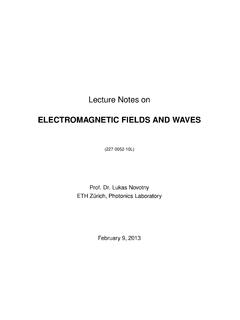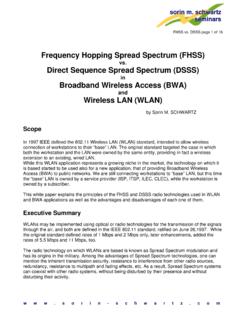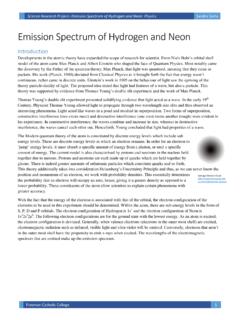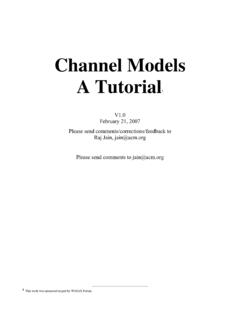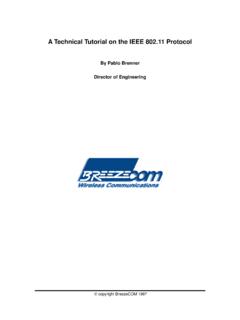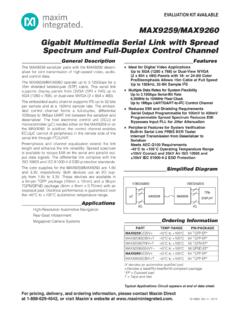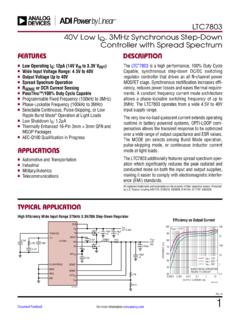Transcription of Chapter 7 Angular Spectrum Representation
1 Chapter 7 Angular Spectrum RepresentationThe Angular Spectrum Representation is a mathematical technique to describe op-tical fields in homogeneous media. Optical fields are described as a superpositionof plane waves and evanescent waves which are physically intuitive solutions ofMaxwell s equations. The Angular Spectrum representationis found to be a verypowerful method for the description of laser beam propagation and light , in the paraxial limit, the Angular Spectrum Representation becomesidentical with the framework of Fourier optics which extends its importance this Chapter we will consider purely monochromatic fieldsof Angular fre-quency , which can be represented as complex fieldsE(r)according to ( 2)E(r,t) = Re{E(r) e i t}.
2 ( )In situations where the field is not time-harmonic, we simplyreplace the complexfieldE(r)by the Spectrum E(r, )and obtain the time-dependent field by Fouriertransformation (see Section ).By the Angular Spectrum Representation we understand the series expansion ofan arbitrary field in terms of plane (and evanescent) waves with variable amplitudesand propagation directions (see Section ). Assume we know the electric fieldE(r)at any pointr= (x,y,z)in space. For example,E(r)can be the solution ofan optical scattering problem, as shown in Fig. , for whichE=Einc+Escatt.
3 Inthe Angular Spectrum picture, we draw an arbitrary axiszand consider the fieldE9798 Chapter 7. Angular Spectrum REPRESENTATIONin a planez= const. transverse to the chosen axis. In this plane we can evaluatethe two-dimensional Fourier transform of the complex fieldE(r) =E(x,y,z)as E(kx, ky;z) =14 2 Z ZE(x, y, z) e i[kxx+kyy]dxdy ,( )wherex,yare the Cartesian transverse coordinates andkx,kythe correspondingspatial frequencies or reciprocal coordinates. Similarly, the inverse Fourier trans-form reads asE(x, y, z) = Z Z E(kx, ky;z) ei[kxx+kyy]dkxdky.( )Notice that in the notation of Eqs.
4 ( ) and ( ) the fieldE= (Ex,Ey,Ez)and itsFourier transform E= ( Ex, Ey, Ez)represent vectors. Thus, the Fourier integralshold separately for each vector far we have made no requirements about the fieldE, but we will assume thatin the transverse plane the medium is homogeneous, isotropic, linear and source-free. Then, a time-harmonic, optical field with Angular frequency has to satisfyEincEscattzz = : In the Angular Spectrum Representation the fields are evaluated inplanes (z= const.) perpendicular to an arbitrarily chosen vector Helmholtz equation ( Equation )( 2+k2)E(r) = 0,( )wherekis determined byk= ( /c)nandn= is the index of the Fourier Representation ofE(r)(Eq.)
5 Into the Helmholtz equationand definingkz q(k2 k2x k2y)with Im{kz} 0,( )we find that the Fourier Spectrum Eevolves along thez-axis as E(kx, ky;z) = E(kx, ky; 0) e ikzz.( )The sign specifies that we have two solutions that need to be superimposed:the+sign refers to a wave propagating into the half-spacez >0whereas the sign denotes a wave propagating intoz <0. Equation ( ) tells us that the Fourierspectrum ofEin an arbitraryimage planelocated atz= be calculated bymultiplying the Spectrum in theobject planeatz= 0by the factorexp( ikzz). Thisfactor is called thepropagatorin reciprocal space.
6 In Eq. ( ) we defined thatthe square root leading tokzrenders a result with positive imaginary part. Thisensures that the solutions remain finite forz . Inserting the result of Eq. ( )into Eq. ( ) we finally find for arbitraryzE(x, y, z) = Z Z E(kx, ky; 0) ei[kxx+kyy kzz]dkxdky( )which is known as theangular Spectrum Representation . In a similar way, we canalso represent the magnetic fieldHby an Angular Spectrum asH(x, y, z) = Z Z H(kx, ky; 0) ei[kxx+kyy kzz]dkxdky.( )By using Maxwell s equationH= (i 0) 1( E)we find the following relation-ship between the Fourier spectra Eand H Hx=Z 1 [(ky/k) Ez (kz/k) Ey],( ) Hy=Z 1 [(kz/k) Ex (kx/k) Ez], Hz=Z 1 [(kx/k) Ey (ky/k) Ex],100 Chapter 7.
7 Angular Spectrum Representation whereZ =p( 0 )/( 0 )is the wave impedance of the medium. Although theangular spectra ofEandHfulfill Helmholtz equation they are not yet rigoroussolutions of Maxwell s equations. We still have to require that the fields are diver-gence free, E= 0and H= 0. These conditions restrict the k-vector todirections perpendicular to the spectral amplitudes (k E=k H= 0).For the case of a purely dielectric medium with no losses the index of refrac-tionnis a real and positive quantity. The wavenumberkzis then either real orimaginary and turns the factorexp( ikzz)into an oscillatory or exponentially de-caying function.
8 For a certain(kx, ky)pair we then find two different characteristicsolutions: plane waves withk2x+k2y k2and evanescent waves withk2x+k2y> k2(see Section ). Propagation and Focusing of FieldsWe have established that, in a homogeneous space, the spatial Spectrum Eofan optical fieldEin a planez=const. (image plane) is uniquely defined by thespatial Spectrum in a different planez= 0(object plane) according to the linearrelationship E(kx, ky;z) = H(kx, ky;z) E(kx, ky; 0),( )where His the so-calledpropagator in reciprocal space H(kx, ky;z) = e ikzz( )also referred to as theoptical transfer function(OTF) in free space.
9 Remem-ber that the longitudinal wavenumber is a function of the transverse wavenumber, [k2 (k2x+k2y)]1/2, wherek=nk0=n /c=n2 / . The sign indicatesthat the field can propagate in positive and/or negativezdirection. Equation ( )can be interpreted in terms of linear response theory: E(kx, ky; 0)is the input, His a filter function, and E(kx, ky;z)is the output. The filter function describes thepropagation of an arbitrary Spectrum through space. Hcan also be regarded asthe response function because it describes the field atzdue to a point source atz= 0. In this sense, it is directly related to the Green s function PROPAGATION AND FOCUSING OF FIELDS101 The filter His an oscillating function for(k2x+k2y)< k2and an exponentiallydecreasing function for(k2x+k2y)> k2.
10 Thus, if the image plane is sufficientlyseparated from the object plane, the contribution of the decaying parts (evanescentwaves) is zero and the integration can be reduced to the circular area(k2x+k2y) k2. In other words, the image atzis alow pass filteredrepresentation of theoriginal field atz= 0. The spatial frequencies(k2x+k2y)> k2of the original fieldare filtered out during propagation and the information on high spatial variationsgets lost. Hence, there is always a loss of information on propagating from near-to far-field and only structures with lateral dimensions larger than x 12k= 4 n( )can be imaged with sufficient accuracy.


